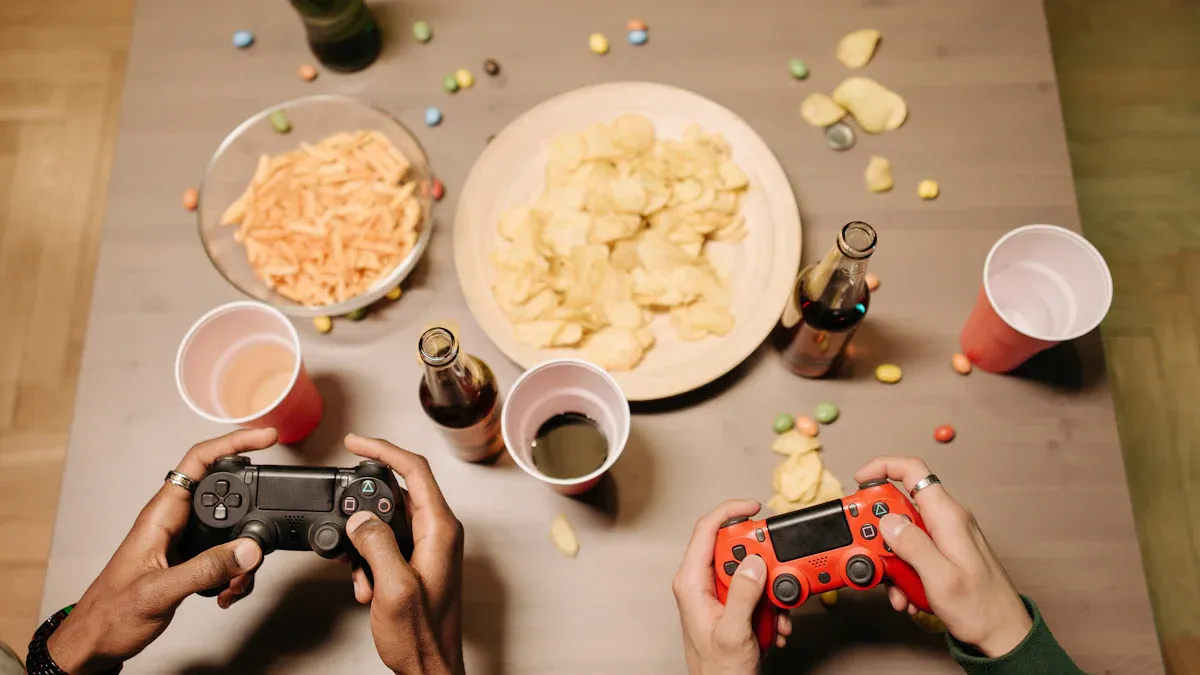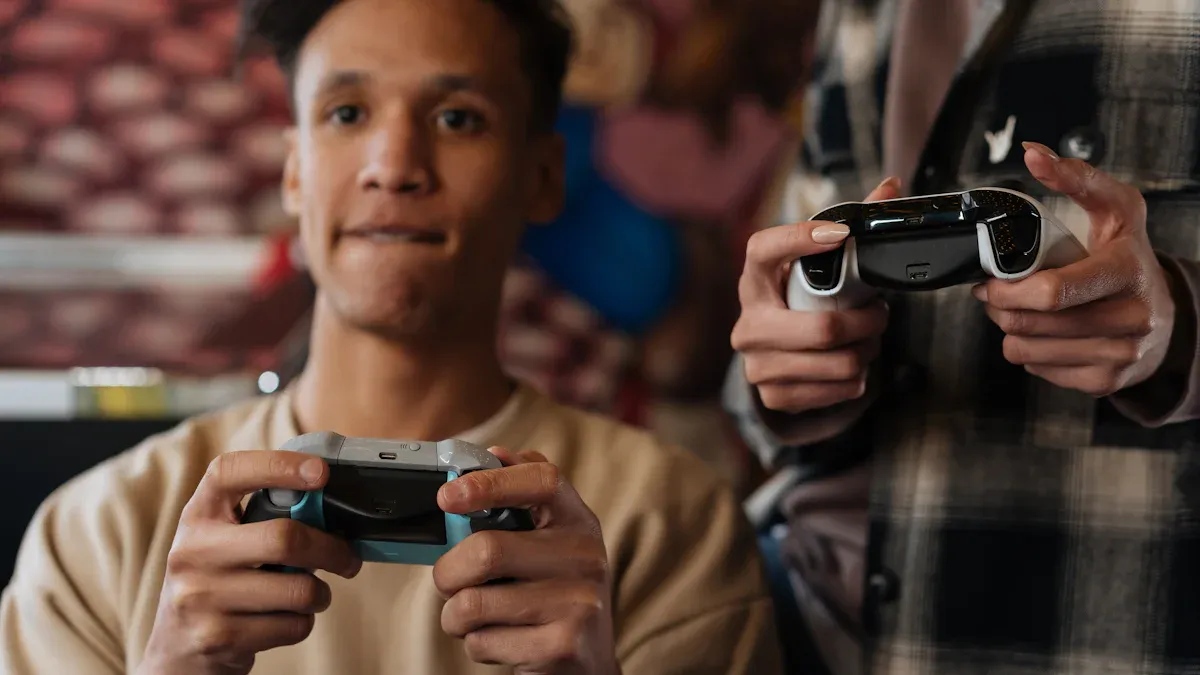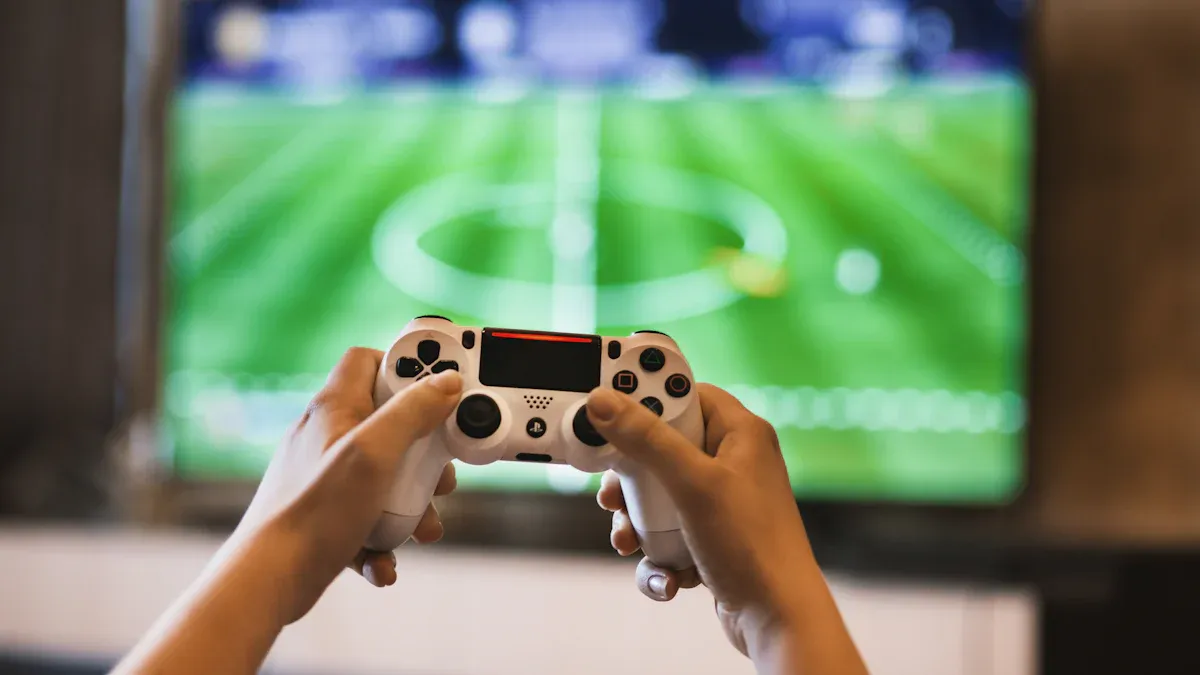Level-Up Loyalty: Re-imagining Points Through Play Mechanics

Loyalty programs have become a cornerstone of customer retention. They reward you for sticking with your favorite brands, making you feel valued. Did you know that 84% of consumers are more likely to stay loyal to brands offering such programs? That’s the power of a well-crafted loyalty system.
But here's the catch—traditional programs often rely on basic point systems that feel transactional. This is where play mechanics come in. By blending elements of gaming, like challenges and rewards, brands can transform these systems into something exciting. Gamification has already boosted customer engagement by 48%, showing its potential to create experiences you actually enjoy.
With this approach, loyalty programs can go beyond transactions. They can build meaningful connections, turning routine purchases into moments of fun. It’s time to embrace Level-Up Loyalty and make every interaction more rewarding.
Key Takeaways
Adding game-like features can increase customer interest by 48%. Brands can make loyalty programs more fun this way.
Emotional bonds are key for loyalty. People like experiences more than discounts, so brands should build connections.
Custom challenges keep people interested. Giving rewards based on what customers like feels more special.
Leaderboards create friendly competition and teamwork. They make loyalty programs more social and enjoyable.
AI helps make loyalty programs better. Brands can use data to create experiences that match customer habits.
The Challenges of Traditional Loyalty Programs
Over-reliance on Extrinsic Rewards
Traditional loyalty programs often focus on external rewards like discounts, points, or freebies. While these perks grab your attention initially, they can quickly lose their appeal. Predictable rewards make the experience feel routine, leaving little room for excitement.
"Rewards that feel too predictable and routine can lead to stagnation in customer engagement."
When loyalty programs concentrate solely on transactions, they miss the bigger picture—the emotional connection with you as a customer. Outdated systems also fail to capture your behavior holistically, making it harder for brands to offer personalized experiences.
Lack of Emotional Connection
Have you ever felt like a loyalty program was just about numbers? Many programs lack the emotional touch that makes you feel truly valued. Research shows that 80% of customers prefer better experiences over cheaper prices. This highlights how important emotional connections are for long-term loyalty.
Key Findings | Details |
|---|---|
Emotional Connections | Building emotional connections is essential for loyalty beyond rewards. |
Customer Preferences | 80% of respondents prefer better customer experience over cheaper pricing. |
Feedback Mechanisms | Private sharing tools yield more candid feedback than traditional surveys. |
Programs that focus only on rational benefits, like discounts, miss the chance to create meaningful relationships. To truly engage you, brands need to move beyond transactional rewards and tap into your emotions.
Difficulty in Sustaining Long-Term Engagement
Keeping you engaged over time is one of the toughest challenges for loyalty programs. Your preferences evolve, and brands need to adapt. Engagement isn’t static—it requires ongoing effort to stay relevant.
Engagement evolves as your preferences change.
Brands must adapt their strategies to maintain your interest.
Human interaction and trust play a key role in keeping you loyal.
Digital communication can help overcome barriers, like hesitancy to interact with luxury brands. However, brands must continuously innovate to ensure their loyalty programs remain exciting and meaningful for you.
By addressing these challenges, brands can embrace Level-Up Loyalty to create programs that are not only rewarding but also emotionally engaging and sustainable.
Understanding Play Mechanics

Core Elements of Play Mechanics
Play mechanics are the building blocks that make games so captivating. They’re the rules, systems, and interactions that keep you engaged and coming back for more. When applied to loyalty programs, these elements can transform a simple transaction into an exciting experience.
Here’s what makes play mechanics tick:
Challenges: Tasks that push you to achieve something, like earning points for completing specific actions.
Rewards: Incentives that make your effort worthwhile, whether it’s unlocking a discount or gaining exclusive perks.
Progression: A sense of growth, like leveling up or earning badges, that keeps you motivated.
Social Interaction: Features like leaderboards or team challenges that let you connect with others and compete.
These elements aren’t just fun—they’re powerful tools for engagement. For example, Duolingo uses streaks and leaderboards to keep you motivated, resulting in over 500 million downloads and a valuation of over $6 billion. Similarly, Starbucks Rewards incorporates gamified challenges, turning coffee purchases into a playful experience.
Gamification isn’t just about entertainment. Businesses with gamified loyalty programs see a 22% increase in customer retention, and websites with gamification features experience a 29% boost in engagement. It’s clear that play mechanics can elevate customer loyalty to new heights.
The Psychology of Engagement Through Play
Why do games captivate you so much? It’s all about psychology. Play taps into your intrinsic motivation—the internal drive that makes you want to achieve, connect, and grow.
Psychological studies show that three factors—autonomy, competence, and relatedness—are key to engagement:
Aspect of Study | Findings | Description |
|---|---|---|
Psychological Benefits | Autonomy, Competence, Relatedness | These factors enhance intrinsic motivation, which is crucial for engagement. |
Customer Engagement | Conscious Participation, Enthusiasm, Social Interaction | These elements lead to higher customer value creation. |
Value Creation | Functional, Hedonic, Social Value | Engagement positively impacts these values, influencing purchasing behavior. |
When loyalty programs incorporate play mechanics, they tap into these psychological drivers. For instance, earning points for completing missions gives you a sense of competence. Leaderboards foster social interaction, while personalized challenges create a feeling of autonomy.
This isn’t just theory—it works in practice. A Fortune 500 company gamified its loyalty initiative, tripling site visits and increasing return visits by nearly 1,000%. Another example is LiveOps, Inc., which gamified call center operations, reducing onboarding time to 14 hours and boosting agent performance by 23%.
Differentiating Play Mechanics from Traditional Rewards
Traditional loyalty programs rely on external rewards like discounts or freebies. While these perks are nice, they often lack the depth to keep you engaged long-term. Play mechanics, on the other hand, offer a richer experience.
Here’s how they differ:
Aspect | Play Mechanics | Traditional Reward Methods |
|---|---|---|
Feedback Mechanism | Conventional feedback functions | |
Motivation | Encourages self-efficacy through mission completion | Often relies on external rewards |
Comparison | High/low points on leaderboards for motivation | Less emphasis on comparative scoring |
Operant Conditioning | Points as reinforcement for desired activities | Rewards typically given without direct engagement |
Exchange Mechanism | Points exchanged for educator-defined rewards | Rewards not tied to a point exchange system |
Play mechanics focus on intrinsic motivation, making you feel accomplished and connected. They’re dynamic, evolving with your preferences and keeping you engaged. Traditional rewards, while effective in the short term, often fail to create the emotional connection needed for lasting loyalty.
By embracing Level-Up Loyalty, brands can shift from transactional systems to experiences that truly resonate with you. Gamification can boost customer retention by up to 30%, and engagement levels can increase by 100%-150% compared to traditional methods. It’s a game-changer for loyalty programs.
Level-Up Loyalty: Real-World Applications

Starbucks Rewards: Gamified Challenges
Have you ever noticed how Starbucks makes your coffee runs feel like a game? That’s the magic of their Starbucks Rewards program. It’s not just about earning stars for free drinks—it’s about keeping you engaged with gamified challenges that make every visit exciting.
Here’s how it works:
You earn stars for every purchase, which you can redeem for free items.
The program includes levels, badges, and exclusive offers to keep things fresh.
Special challenges encourage you to try new products or visit more often.
Feature | Details |
|---|---|
Program Name | Starbucks Rewards |
Active Members | |
Gamification Elements | Levels, points, badges, challenges |
Customer Benefits | Earn stars for purchases, redeem for free items, exclusive offers |
Impact on Sales | Significant contribution to Starbucks' sales and customer loyalty |
This approach has turned Starbucks Rewards into more than just a loyalty program. It’s a fun, interactive experience that keeps you coming back for more. By incorporating gamified challenges, Starbucks has mastered the art of Level-Up Loyalty, creating a system that feels rewarding and engaging at the same time.
Nike Run Club: Progression Systems in Action
If you’ve ever used the Nike Run Club app, you know it’s not just about tracking your runs. It’s about making every step feel like progress. Nike has built a progression system that motivates you to keep going, whether you’re a beginner or a seasoned runner.
Here’s what makes it so effective:
Monthly Challenges: Set distance goals and earn milestone badges.
Social Competition: Compete with friends on leaderboards or see how your city ranks.
Real-Time Feedback: Get audio cheers and confetti animations as instant rewards.
Immersive Storytelling: Themed runs turn your workouts into adventures.
Metric | Description |
|---|---|
Challenges & Achievements | Monthly distance goals and milestone badges create a quest mentality. |
Social Competition | Friends leaderboards and city-wide rankings tap into competitive instincts. |
Real-Time Feedback | Audio cheers and confetti animations provide instant rewards. |
Immersive Storytelling | Themed runs transform workouts into narrative experiences. |
User Engagement | One of the most engaged fitness communities with millions of active users. |
Increased Motivation | 72% of users report increased motivation due to the achievement system. |
Nike’s progression system doesn’t just track your performance—it celebrates it. By turning fitness into a game, they’ve created one of the most engaged fitness communities in the world. This is a perfect example of how Level-Up Loyalty can inspire long-term commitment through meaningful experiences.
Gaming Insights: Leaderboards and Social Competition
Leaderboards aren’t just for video games—they’re a powerful tool for loyalty programs too. They tap into your competitive side, making every interaction feel like a chance to climb the ranks. Whether it’s a team-based leaderboard or an individual one, the thrill of competition keeps you coming back.
Aspect | Findings |
|---|---|
Trait Competitiveness | Indirectly influences usage intention through perceived enjoyment. |
Leaderboard Design | Team-based leaderboards are more effective than player-based ones. |
Trait Competitiveness | Ranking Effect on Learning Motivation | Ranking Effect on Performance |
|---|---|---|
Low | N/A | |
High | Lower rankings improve performance. | N/A |
Leaderboards also foster social interaction. Competing with others, whether friends or strangers, creates a sense of community. This dynamic is why gaming companies have seen such success with leaderboards. For example, studies show that higher rankings can boost motivation, while lower rankings can drive performance improvements.
By integrating leaderboards into loyalty programs, brands can create a sense of friendly rivalry that keeps you engaged. It’s another way Level-Up Loyalty can transform ordinary interactions into something extraordinary.
Industry-Specific Applications of Play Mechanics
Retail: Personalized Challenges and Rewards
Retailers have embraced play mechanics to create loyalty programs that feel personal and exciting. Instead of generic discounts, they now offer challenges tailored to your shopping habits. This approach not only keeps you engaged but also makes you feel valued.
For example:
In 2023, the retail sector accounted for 28.5% of the gamification market revenue. This shows how crucial gamified loyalty programs are for boosting customer engagement.
Supermarket loyalty members often earn points weekly and redeem them every two weeks, showing how frequently these programs are used.
Brands like Carrefour and Tesco have taken this a step further. Carrefour uses AI to set reward thresholds based on your purchase history, while Tesco’s Clubcard Challenges have positively impacted over 10 million customers. These personalized challenges encourage you to shop more often and spend more, making loyalty programs feel like a fun game.
Hospitality: Immersive Loyalty Experiences
In the hospitality industry, loyalty programs are no longer just about points. They’re about creating unforgettable experiences that make you want to return. Hotels are using play mechanics to immerse you in their brand, offering personalized services and interactive rewards.
Hotel Brand | Strategies | Results |
|---|---|---|
Ritz-Carlton | - Personalized Guest Experiences | - Increased Guest Satisfaction |
Marriott International | - Digital Transformation | - High Occupancy Rates |
Hilton | - Personalized Services | - Enhanced Guest Loyalty |
These strategies show how hotels are using play mechanics to create emotional connections with guests. Whether it’s through seamless technology or personalized experiences, these programs make you feel like more than just a customer.
E-commerce: Data-Driven Customization
E-commerce platforms are leveraging data to make loyalty programs smarter and more engaging. By analyzing your shopping behavior, they can offer personalized deals and recommendations that feel tailor-made for you.
Here’s why this works:
57% of customers are willing to share detailed information for personalized deals.
Personalization can increase revenue by 26% and reduce bounce rates by 45%.
90% of top marketers believe personalization boosts profitability.
When you shop online, these platforms use play mechanics to keep you coming back. Whether it’s through gamified discounts or exclusive offers, they make every interaction feel rewarding. This is the essence of Level-Up Loyalty—turning ordinary shopping into an engaging experience that keeps you loyal.
Future Trends in Level-Up Loyalty Programs
AI-Driven Personalization
Imagine a loyalty program that knows exactly what you want before you do. That’s the power of AI-driven personalization. By analyzing your preferences and behavior, AI creates tailored experiences that feel uniquely yours. For example, Netflix uses AI to recommend shows you’ll love, saving $1 billion annually by reducing churn. Similarly, Starbucks boosts customer engagement by 15% with personalized drink suggestions.
Company | Impact on Loyalty and Engagement | Key Metrics |
|---|---|---|
Netflix | Enhanced user engagement and loyalty through personalized content recommendations. | Saves about $1 billion per year by reducing churn; personalized recommendations have a take-rate 3–4 times higher than generic lists. |
Starbucks | Increased customer engagement and ROI through personalized drink recommendations and offers. | 30% increase in ROI on marketing initiatives; 15% rise in customer engagement levels. |
AI doesn’t just improve recommendations. It also enables dynamic reward structures that adapt to your real-time behavior. This means your rewards evolve as you do, keeping the experience fresh and exciting. Businesses using AI in loyalty programs report a 15-30% ROI improvement, thanks to better targeting and resource allocation.
Gamification Technologies and Augmented Reality
Gamification is no longer just a buzzword—it’s a game-changer. Companies using gamified loyalty programs see a 22% increase in customer retention. Why? Because gamification taps into your natural desire for achievement and competition. It triggers dopamine release, making every interaction more rewarding.
Now, add augmented reality (AR) to the mix, and the possibilities become endless. AR can turn loyalty programs into immersive experiences. Imagine scanning a product in-store to unlock hidden rewards or using an app to visualize how furniture fits in your home. With the AR market projected to hit $41.8 billion by 2028, this technology is set to redefine engagement.
Community-Centric Loyalty Models
Loyalty programs are shifting from individual rewards to fostering communities. Virtual brand communities, where you can interact, share experiences, and feel part of something bigger, are becoming the norm. Studies show that these communities enhance brand loyalty by creating a strong sense of identity.
For example, brands now focus on offering entertainment, information, and interaction within these communities. This approach not only strengthens your connection to the brand but also makes the loyalty program feel more meaningful. By prioritizing community engagement, companies are building loyalty models that go beyond transactions—they’re creating lasting relationships.
Play mechanics have revolutionized loyalty programs, turning them into dynamic, engaging experiences. They boost customer engagement by up to 47% and reduce churn by 63%, proving their transformative power. Personalization and emotional connections are key. When you feel valued and entertained, you’re more likely to stay loyal.
To get started, brands can track metrics like Net Promoter Score (NPS) and Repeat Purchase Rate (RPR). These tools measure customer satisfaction and loyalty. By adding gamified challenges and rewards, businesses can create loyalty programs that are fun, meaningful, and unforgettable.
Metric | Impact |
|---|---|
Customer engagement increase | Up to 47% |
Brand loyalty boost | 22% |
Wallet share increase | 55% |
Churn reduction | 63% |
Gamification isn’t just a trend—it’s the future of loyalty.
FAQ
What are play mechanics in loyalty programs?
Play mechanics are game-like elements added to loyalty programs. They include challenges, rewards, and progression systems that make earning points fun and engaging. Instead of just collecting points, you complete tasks, level up, or compete with others to stay motivated.
How do play mechanics improve customer loyalty?
They make loyalty programs exciting by tapping into your emotions and competitive spirit. You feel rewarded not just for spending money but for participating in fun activities. This creates a stronger connection with the brand and keeps you coming back.
Can small businesses use gamification in loyalty programs?
Absolutely! Small businesses can start with simple gamified elements like punch cards, milestone rewards, or leaderboards. These features don’t require big budgets but still make your loyalty program more interactive and appealing to customers.
Are gamified loyalty programs expensive to implement?
Not always. Many tools and platforms offer affordable gamification features. You can start small with basic challenges or rewards and scale up as your program grows. The key is to focus on creating meaningful experiences for your customers.
What industries benefit most from gamified loyalty programs?
Retail, hospitality, and e-commerce see the biggest benefits. However, any industry can use gamification to boost engagement. Whether it’s fitness apps, restaurants, or even education platforms, play mechanics can make loyalty programs more effective and fun.
See Also
Debunking Personalization Myths and Revealing The Truths
Why Need-Based Recommendations Outperform Traditional Purchase Lists
NinjaVan's Transformation: From Classic Spark To Lakehouse
Atlas' Experience: Turning Data Challenges Into Opportunities
Understanding Route Optimization Algorithms For Speedy Deliveries

